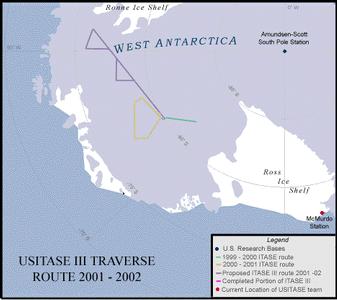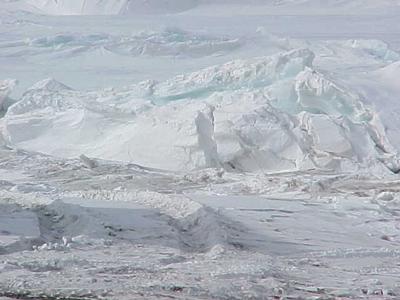6 November, 2001
All 15 of us are now here
Temperature: -8 deg C (18 deg. F)
Wind Chill: -14 deg. C (8 deg. F)
Now that everyone that will be on the traverse has arrived, we all met
first thing in the morning to introduce ourselves and review some of the
details of the trip. We come from all over the U.S. and it's the first
time since the logistical meeting in Boston that we've met as a group.
Gordon handed out the map of the traverse route (see below) and Paul
brought us up-to-date on the radios and satellite phones that we'll have.
Although we'll have email access on one phone, it is apparently too slow to
transmit a lot of text. One sentence took 20 minutes on the test run, so
I'm not sure yet how we will handle these daily updates. We also went over
to the NSF Chalet to meet with the staff that is coordinating the trip and
providing logistical support. Everyone is very pleased that we will be
using two Challenger tractors this year so that we can travel a lot faster
than they did last year. We will now be able to travel 10-12
kilometers/hour. Watch out Mario Andretti! Our first leg to the first
drilling site is 300 kilometers, so we will be traveling about 30 hours.
The plan is to alternate drivers so everyone can sleep at some point.
After lunch everyone went off to take care of any unfinished business.
Most of the people who just came in had to go to a snow-school refresher
course. I walked over to Scott Base, which is the New Zealand Station
here. It is much smaller than McMurdo and they ask that no Americans go
there unless it is to visit the store or to go by invitation. Scott Base
is on the other side of Observation Hill and is between McMurdo and where
they hold snow school. It is a nice half hour walk along a dirt road and I
enjoyed seeing a different view of the mountains. One neat thing I saw was
the boundary between the sea ice and the land ice. They push against each
other to form a disrupted pattern and short cliffs in the ice.
I'd like to introduce a few more members of our expedition: Steve Arcone,
Allen Delaney, Dave Schneider, Blue Spikes and Mark Wumpkes. Steve and
Allen are working together to use radar for finding crevasses so we can
avoid them while traveling. They will also be using the radar to study the
layers in the ice and snow for the past two hundred years. Dave will be
analyzing the ice cores for the stable isotopes of oxygen and hydrogen. The
isotopes preserved in polar snow are used to help understand how climate
has changed in the past. Blue will be helping Gordon measure how fast the
ice sheet is flowing and how much the ice sheet is thickening or thinning.
They do this by tracking the movement of markers in ice with GPS (Global
Positioning System) receivers. Mark is our drilling specialist and will be
operating an electromechanical drill to produce 3-4 inch diameter ice core
samples. We expect to drill between 60-150 meters in depth, depending on
our location.

Morning meeting

Map of our route. We will fly from McMurdo (red dot) to Byrd Camp, and from there we will travel by tractors to Siple Dome.

New Zealand's Scott Base.

The boundary where the sea ice and land ice meet.
Contact the TEA in the field at
.
If you cannot connect through your browser, copy the
TEA's e-mail address in the "To:" line of
your favorite e-mail package.
|
